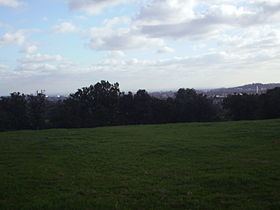Topo map OS Explorer 173 | OS grid TQ138928 Elevation 144 m | |
 | ||
Grim's Ditch or Grim's Dyke or Grimes Dike is an earthwork in the London Borough of Harrow, close to the Hertfordshire borderline. It extends about three miles from Pinner Green to Harrow Weald Common. It takes its name from the prehistoric earthwork which is one of a number of Grim's Ditches in southern England.
Contents
Map of Grim's Ditch, Harrow, UK
The highroad Old Redding passes through the centre of the trail which can be reached either by Oxhey Lane or Bushey Heath and includes a popular viewpoint for many locals. However views are actually more extensive through the breaks in the trees a few hundred yards further up the high road. Some of these are surprising for a low hill. A vast majority of Central London can be seen in clear conditions. Beyond Harrow on the Hill to the south, Leith Hill can be seen; its 20-metre-high tower can even be seen with binoculars. To the north and west there are clear views of the Chilterns, and in particular Coombe Hill, Buckinghamshire can be seen.
The highest point of the trail, which is close to the county top of Middlesex, is just above the Grim's Dyke Golf Club which can be passed using the 'Bushey Heath Walk' footpath. The walk eventually extends through a small wood with a BT microwave aerial prominent. Close to the aerial's enclosure is a Stone Marker created by the Harrow Heritage Trust that reads: 'This ancient earthwork once stretched through Harrow for some six miles from Cuckoo Hill, Pinner to Pear Wood, Stanmore, but now only parts remain. Named after Grim (another name for the English King of the gods (also the god of death), Woden).'
In the woods stands Grim's Dyke, a house designed in 1870 by Norman Shaw for the Victorian painter Frederick Goodall. Later, it was the country home of W. S. Gilbert (of Savoy opera fame) – he suffered a heart attack and drowned while trying to save a swimmer in the lake in the grounds. It is now an hotel and is often used as a film location. The house and its gatehouse are both listed buildings.
The earthwork also gave its name to the telephone exchange serving Stanmore: GRImsdyke (as it was normally written).
History
Grim's Dyke had generally been dated as fifth to sixth century AD, but an excavation in 1979 produced a radiocarbon date of 50 AD +- 80 years, which while not conclusive suggests a much earlier date. It may have been built by the Catuvellauni tribe as a defence against the Romans.
